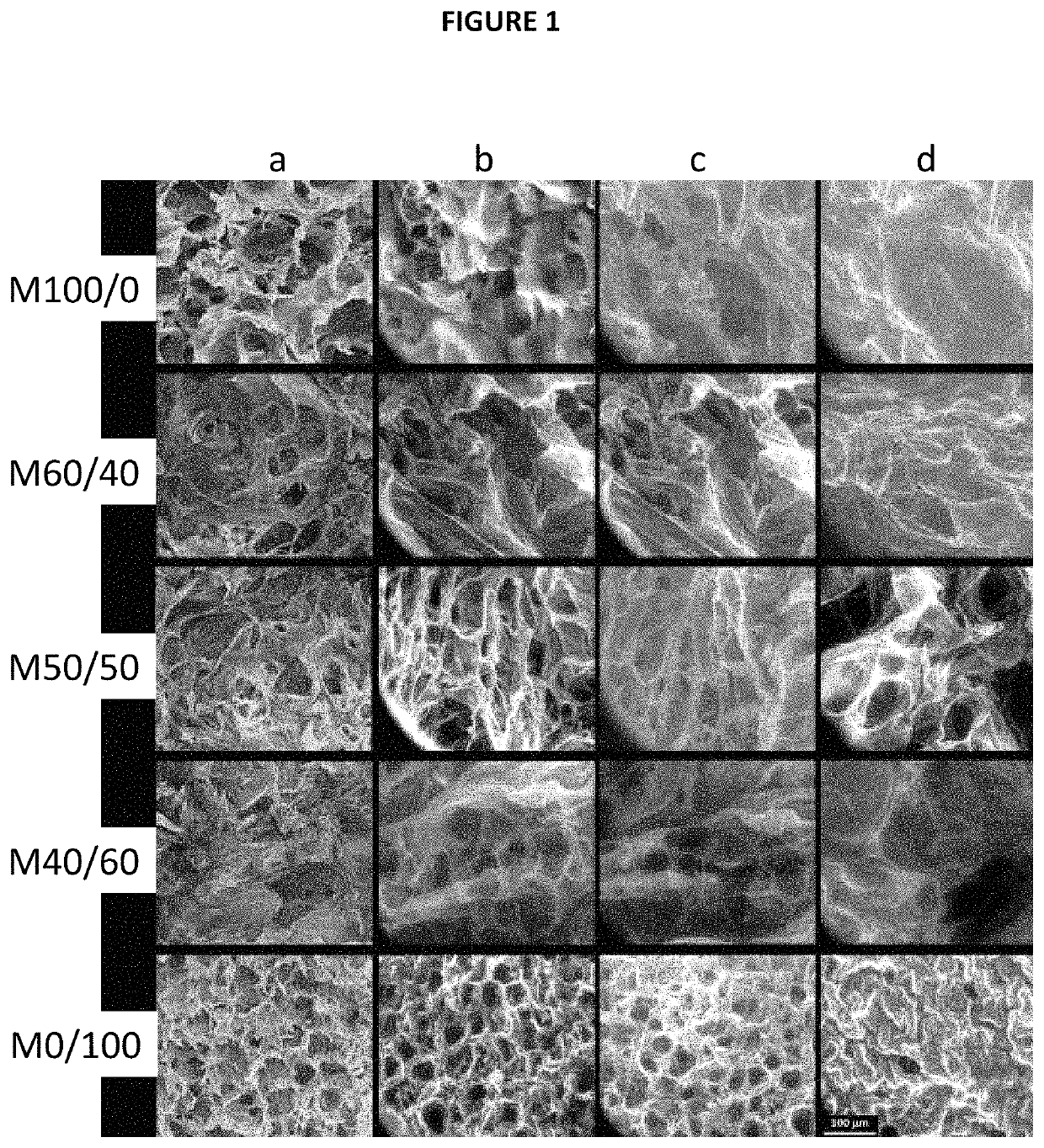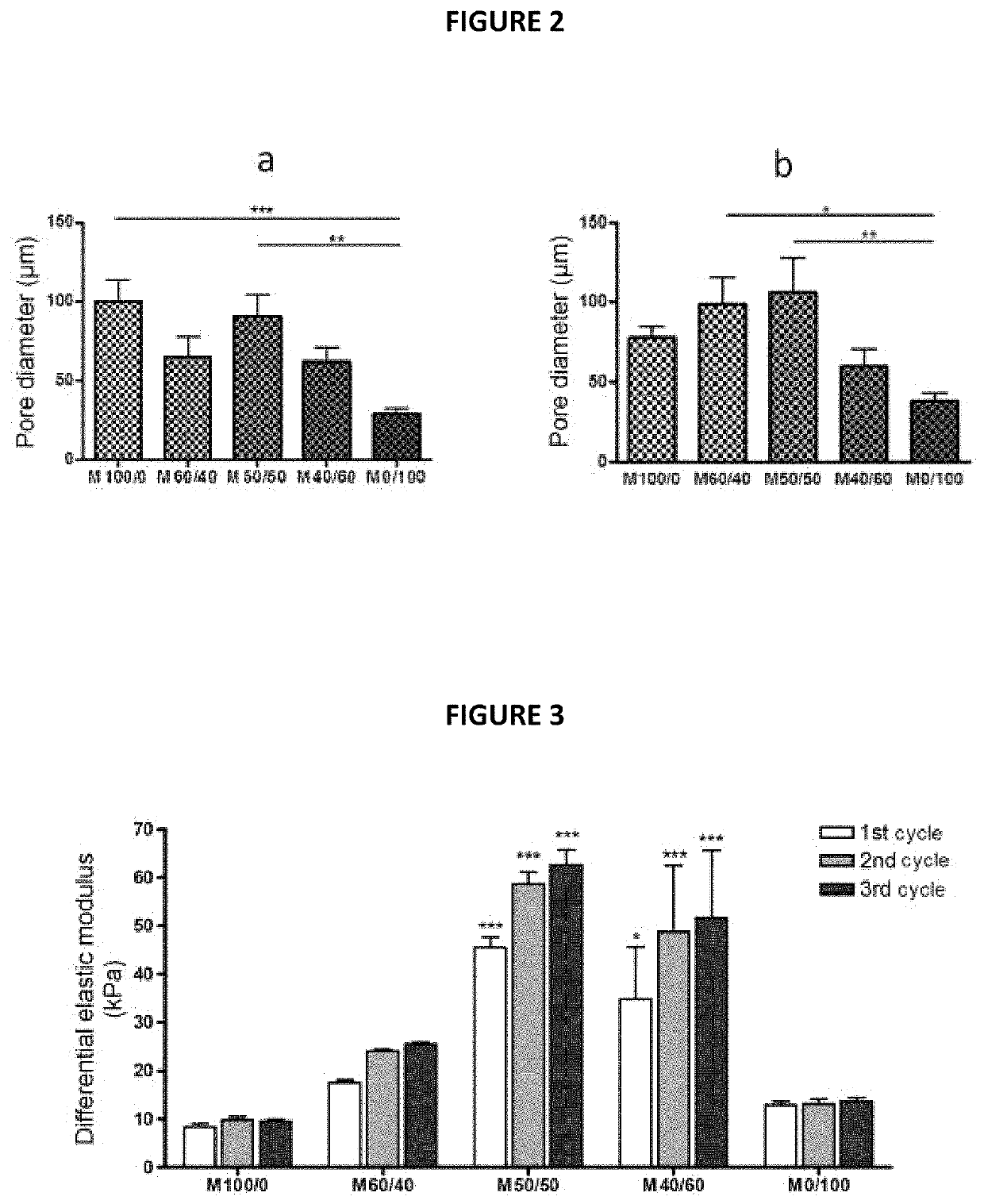Process for preparing biocompatible and biodegradable porous three-dimensional polymer matrices and uses thereof
a three-dimensional polymer matrix and porous technology, applied in the field of preparing porous three-dimensional polymer matrix, can solve the problems of limited commercial interest in alginate xerogels, limited beneficial effects, and low cell survival rate (15%), and achieve good mechanical properties and high porousness
- Summary
- Abstract
- Description
- Claims
- Application Information
AI Technical Summary
Benefits of technology
Problems solved by technology
Method used
Image
Examples
example 1
Preparation of Porous Polymer Matrices in Accordance with the Present Invention and of Comparative Porous Polymer Matrices which are Not Part of the Invention—Characterizations
[0145]In this example, porous polymer matrices in accordance with the invention based on alginate as anionic polysaccharide and on chitosan as cationic biocompatible polymer were prepared using various alginate / chitosan weight ratios according to Table 1 below:
[0146]
TABLE 1MatrixMatrixMatrixMatrixMatrixM100 / 0(*)M60 / 4050 / 5040 / 600 / 100(*)Alginate / chitosan100 / 060 / 40505040 / 600 / 100weight ratio(*)Comparative matrices not part of the invention
[0147]1) Preparation of the Polymer Matrices
[0148]The following compositions were prepared:
[0149]Alginate solvent (for 200 g): 1.8 g of NaCl, made up to 200 g with deionized water;
[0150]Chitosan solvent (for 100 g): 0.9 g of NaCl+1.5 g of pure acetic acid (i.e. 0.25 M) and made up to 100 g with deionized water;
[0151]Buffer I (for 1000 g): 9.0026 g of NaCl+3.2540 g of HEPES buffer...
example 2
Study of the Behaviour with Respect to Rehydration of Two Matrices in Accordance with the Present Invention
[0187]In this example, the behaviour with respect to rehydration of the M40 / 60 matrix in accordance with the invention which had undergone an intermediate lyophilization step 3a, as prepared according to the process described above in Example 1 (M40 / 60 L+ matrix), was compared with that of the M40 / 60 matrix in accordance with the invention but which had not undergone this intermediate lyophilization step 3a, as also prepared according to the process described above in Example 1 (M40 / 60 L− matrix).
[0188]To do this, samples of identical diameter of each of these two matrices were immersed in water for 5 min. Photos of each of the matrices taken before and after immersion are given in the appended FIG. 5.
[0189]It can be observed that the M40 / 60 L+ matrix having undergone the intermediate lyophilization step 3a of the process in accordance with the invention swells faster in water ...
example 3
[0190]Evaluation of the Angiogenic Effects of a Matrix in Accordance with the Invention Compared with a Matrix Not in Accordance with the Present Invention
[0191]In this example, the angiogenic effects of the M40 / 60 L+ matrix in accordance with the invention and as prepared above in Example 1 were evaluated in comparison with those of a matrix not in accordance with the invention, obtained according to a preparation process identical in all respects to that of the M40 / 60L+ matrix, except that the last two steps of dehydration and drying with supercritical CO2 were replaced with a further freezing step and then a further lyophilization step, said steps being carried out under the same conditions as the steps for freezing the foam and for lyophilizing the frozen foam, described above in Example 1. Said matrix, which is therefore doubly lyophilized, is called M40 / 60 REF.
[0192]Each of these two matrices was tested after implantation without multiplication in rats (M40 / 60 L+ matrix in acc...
PUM
| Property | Measurement | Unit |
|---|---|---|
| molecular weight | aaaaa | aaaaa |
| molecular weight | aaaaa | aaaaa |
| pressure | aaaaa | aaaaa |
Abstract
Description
Claims
Application Information
 Login to View More
Login to View More - R&D
- Intellectual Property
- Life Sciences
- Materials
- Tech Scout
- Unparalleled Data Quality
- Higher Quality Content
- 60% Fewer Hallucinations
Browse by: Latest US Patents, China's latest patents, Technical Efficacy Thesaurus, Application Domain, Technology Topic, Popular Technical Reports.
© 2025 PatSnap. All rights reserved.Legal|Privacy policy|Modern Slavery Act Transparency Statement|Sitemap|About US| Contact US: help@patsnap.com



